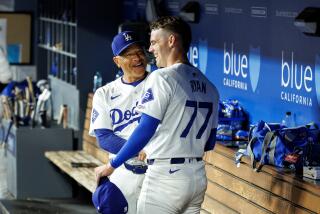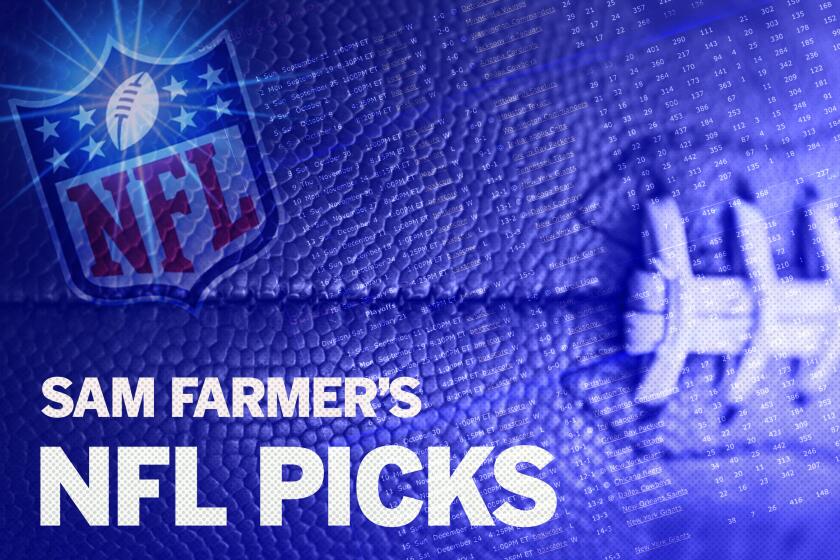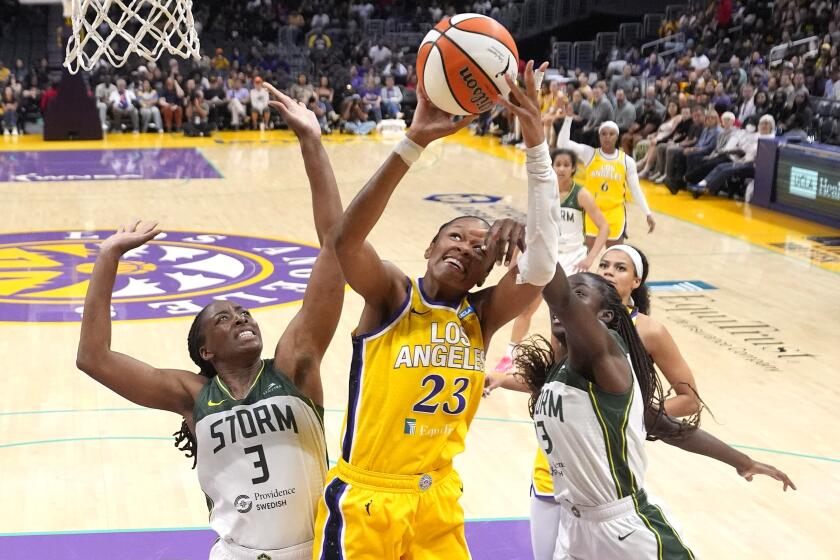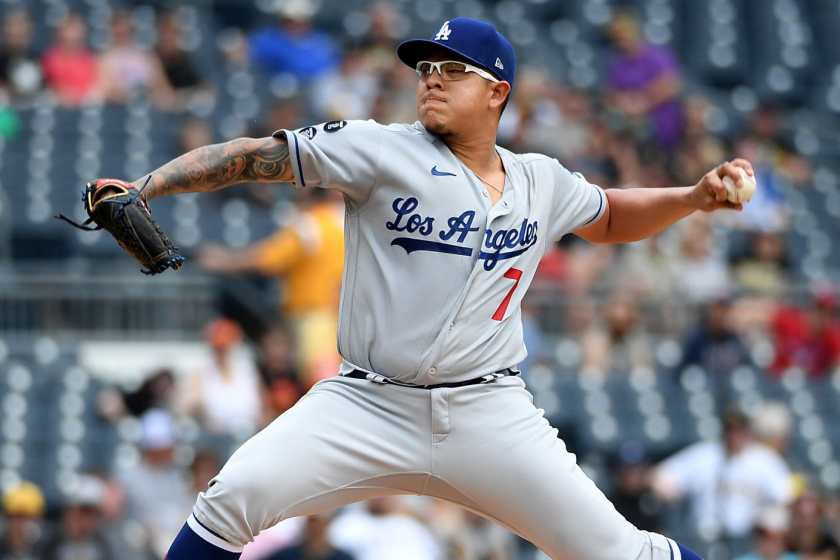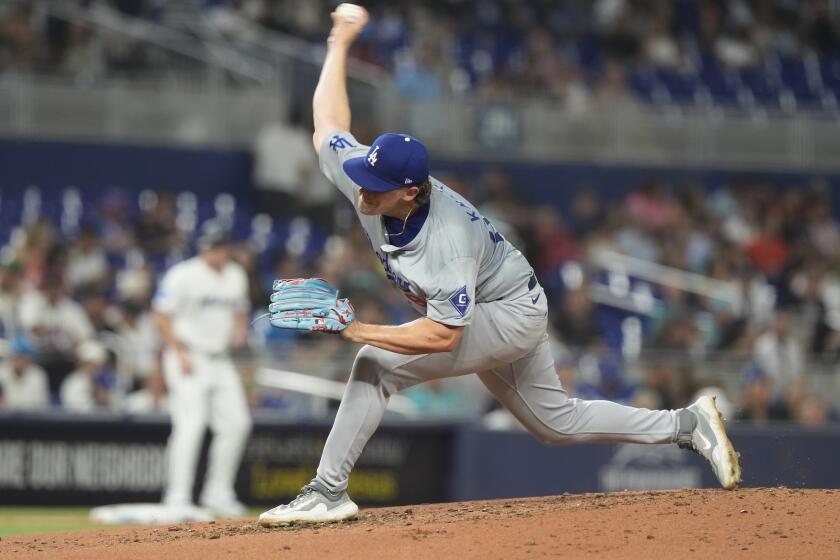Steroid investigation deeply implicates Los Angeles Dodgers
Fans and teammates anointed him the “heart and soul” of the Dodgers, the late-blooming hard-charger whose 2004 trade stung like a betrayal to those who bleed blue.
Now, the explosive report by former U.S. Sen. George Mitchell on the use of steroids and other performance-enhancing drugs in baseball paints a much different picture of Paul Lo Duca. The All-Star catcher is described in the document as the pivot man in the virus-like spread of steroids and human growth hormone through the team clubhouse, to the lockers and doorsteps of then-Dodgers Eric Gagne -- the beloved “Game Over” relief icon -- and pitcher Kevin Brown, and even to the former minor league franchise in Albuquerque.
Lo Duca is portrayed as both consumer and conduit of the drugs, the happy-to-oblige middleman between teammates and Kirk Radomski, a onetime New York Mets clubhouse worker and admitted steroid pusher.
“Thanks,” Lo Duca once wrote to Radomski on Dodger Stadium stationery, the report says. “Call me if you need anything!”
And when Dodgers officials decided to trade Lo Duca, the report suggests, one of the reasons wasn’t his own use of steroids, but the fact that he apparently had stopped taking them.
“Got off the steroids. . . . Took away a lot of hard line drives,” the report quotes from notes of an internal discussion by the officials in 2003. “Can get comparable value back would consider trading. . . . If you do trade him, will get back on the stuff and try to show you he can have a good year. That’s his makeup.”
Perhaps no team comes off worse in the 409-page report than the Dodgers, who are portrayed as nearly top-to-bottom complicit in the steroid culture from roughly 1999 through 2004. The depiction features bundles of cash, one dropped on a front stoop in the rain, a Gagne query on proper injection technique and sober front-office musings on the link between a player’s muscle growth and use of the “stuff” and “meds.”
Dodgers owner Frank McCourt, who bought the team from Rupert Murdoch’s Fox Entertainment Group in early 2004, said in a written statement that he had not read the entire report, but was “steadfast in the belief that performance-enhancing drugs have no place in baseball.”
In addition to Lo Duca, Gagne and Brown, the report names Todd Hundley, Matt Herges, Chris Donnels and Adam Riggs as among the players who used the illicit drugs while in the Dodgers organization. Hundley and Santangelo could not be reached for comment. Agents for the other players either declined comment or did not return phone calls.
The report shows that unnamed Dodgers officials had been highly suspicious, if not plainly aware, that steroids had become part of the Dodgers training regimen, at least where certain players were concerned. The internal team notes excerpted in the report indicate that the officials, including apparently then-general manager Dan Evans, had matter-of-factly assessed which of the players were using the drugs -- and, more important, whether the drugs were helping or hurting them on the field. (Evans declined to comment Thursday.)
“Kevin Brown -- getting to the age of nagging injuries. . . . Question what kind of medication he takes,” the report quotes from the October 2003 team notes. “Common in soccer players and are more susceptible if you take meds to increase your muscles -- doesn’t increase the attachments.
“Is he open to adjusting how he takes care of himself?” the notes continue. “He knows he now needs to do stuff before coming to spring training to be ready. Steroids speculated by GM.”
During the same month, other notes said of Gagne, according to the report: “He probably takes medication and tendons and ligaments don’t build up just muscle.”
Those present at the 2003 meetings, the report said, included Evans, trainer Stan Johnston, manager Jim Tracy, advance scout Mark Weidemaier, team physician Frank Jobe, senior scouting advisor Don Welke and director of amateur scouting Logan White. The notes were taken by Ellen Harrigan, an administrator in the scouting department, and were provided to investigators by the team, according to the report.
Weidemaier said Thursday that during meetings the possibility that some players around the league had used steroids was discussed.
“However, I don’t recall it coming up in regard to any of our own players -- at least not in the meetings I was in,” Weidemaier said.
A former Dodgers executive who requested anonymity said Thursday that “individually, a lot of us may have had our suspicions during that period, but it was difficult to know what was really going on or how to address it.”
The Dodgers’ passages in the Mitchell Report begin with Lo Duca on Page 208, where it is noted that he played seven seasons in L.A. before the trade to the Florida Marlins.
In spring 1999, Albuquerque Dukes conditioning coach Todd Seyler allegedly spoke with five of the minor league players -- including Lo Duca and Herges -- about using the performance enhancer.
Seyler said that he and several players gave Herges money for steroids, and that Herges and Lo Duca became the buyers for the group, with a source in Florida, the report states.
The players and Seyler would meet in an apartment and inject themselves, it says.
During his L.A. tenure, the report says, Lo Duca was referred to Radomski by Hundley, and soon after the Dodgers catcher and Mets clubhouse assistant were exchanging money for drugs.
Radomski told the Mitchell investigators that he sent kits of human growth hormone by overnight mail to Lo Duca’s home or to the Dodgers clubhouse, and the player would send him a check -- typically for $3,200 -- about a week later.
Federal agents found Lo Duca listed in Radomski’s address book when they searched the assistant’s residence. They also found this note from Lo Duca to Radomski, according to the report:
“Sorry! But for some reason they sent the check back to me. I haven’t been able to call you back because my phone is TOAST! I have a new # it is . . . Please leave your # again because I lost all of my phonebook with the other phone. Thanks, Paul.”
The report points out that Lo Duca told Sports Illustrated in 2002 that he understood why a player battling for a job would be tempted to use steroids, but that he added: “Don’t get me wrong. I don’t condone it.”
Lo Duca was dealt to Florida on July 30, 2004. And, the report alleges, he apparently proved correct the speculation by the Dodgers officials that he would turn again to drugs. It says he wrote Radomski another $3,200 check the month after he was traded.
Back in L.A., Gagne remained a Radomski customer, thanks to a Lo Duca introduction, the report alleges. Lo Duca had called up Radomski and told him Gagne was there and wanted to buy human growth hormone, according to the report.
It says Gagne then took the phone and “asked Radomski a question about how to get air out of a syringe. This is the only time Radomski spoke to Gagne. Radomski said that Lo Duca thereafter placed orders on Gagne’s behalf.”
Those orders were posted to Gagne’s Florida home and Dodger Stadium, the report says. Included in the document is a photocopy of a Radomski Express Mail receipt for what is identified as the Aug. 9, 2004, stadium delivery.
On an occasion when Lo Duca didn’t handle the transaction, Gagne sent Radomski $3,200 in cash by Federal Express, the report says.
Later, the report adds, Boston Red Sox officials referred to Gagne’s suspected steroid use while the team was considering signing him. It quotes from a Nov. 1, 2006, e-mail from Boston General Manager Theo Epstein to a Red Sox scout:
“Have you done any digging on Gagne? I know the Dodgers think he was a steroid guy. Maybe so. What do you hear on his medical?”
The report says the scout, Mark Delpiano, responded: “Some digging on Gagne and steroids IS the issue. Has had a checkered medical past throughout career including minor leagues. Lacks the poise and commitment to stay healthy, maintain body and reinvent self.
“What made him a tenacious closer was the max effort plus stuff. . . . Mentality without the plus weapons and without steroid help probably creates a large risk in bounce back durability and ability to throw average while allowing the change-up to play as it once did.”
Gagne has denied using steroids. Meanwhile, Lo Duca had referred Brown to Radomski sometime in 2000 or 2001, the report says, and the steely pitcher spoke to the clubhouse worker for up to two hours about human growth hormone. Radomski sent Brown several shipments of it, and the pitcher paid in cash, sometimes up to $10,000, according to the report.
One $8,000 payment arrived when Radomski was not home, and the package was left unsigned-for at his door in the rain, the report says.
“Radomski called Brown and told him not to check the signature waiver box on the overnight delivery package when he was sending cash, because the envelope was left on Radomski’s doorstep for several hours and could have been taken,” the report says.
It says that Brown also asked Radomski for Deca-Durabolin for an injured elbow.
Lo Duca also put Herges and Riggs in touch with Radomski, the report says. Radomski allegedly sold Riggs six to 10 batches of human growth hormone, clenbuterol and Winstrol from 2003 to 2005, including after he started playing in Japan. (Riggs played with the Angels in 2003 and 2004.)
Herges bought human growth hormone from Radomski from as early as 2004 through late 2005, the report says. At one point, it says, Herges called to make another purchase, not knowing Radomski had started cooperating in the federal investigation.
Radomski is said to have told Herges he “was dry right now.”
Hernandez and Pringle are Times staff writers; Newhan is a special correspondent.
More to Read
Go beyond the scoreboard
Get the latest on L.A.'s teams in the daily Sports Report newsletter.
You may occasionally receive promotional content from the Los Angeles Times.

